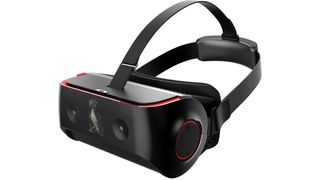Qualcomm wants to show Samsung and HTC how VR should be done
New VR820 headset promises new experiences

When Qualcomm announces a reference design it's not usually the most exciting thing in the world – but with the Snapdragon VR820, the brand has created a rather exciting virtual reality headset.
Sadly, it won't be available for mere mortals to buy – rather it's designed (in association with manufacturer Goertek) to show just how capable the Snapdragon 820 chipset is at powering a VR headset.
The exciting parts come in the form of eye-tracking (with two separate cameras for monitoring both eyeballs) and dual front-facing cameras, so you'll be able to combine the virtual and real worlds for easy augmented reality.
Touchy-feely
The VR820 will also support gesture-based input, Anthony Murray, senior vice president and general manager of IoT at Qualcomm, told TechRadar. This means you'll be able to interact with the virtual world using your hands as well, rather than needing to use a controller.
The VR820 uses two separate OLED displays to show the content in front of your eyes, with the 1440 x 1440 resolution panels being among the sharpest on the market right now – in short, this should all amount to a stunning virtual reality experience, as it offers a blindingly quick 18ms latency.
That means, in layman's terms, that when you move your head there's very little delay as the images move with you, taking the motion sickness most associate with VR down a further notch.

Putting all this on the headset means the processing can be done locally – so you can theoretically stream VR content over to the device and have the heavy lifting done internally… untethered virtual reality.
Get daily insight, inspiration and deals in your inbox
Get the hottest deals available in your inbox plus news, reviews, opinion, analysis and more from the TechRadar team.
Murray told us this headset had been put together as something Qualcomm "had to have" in order to show off the Snapdragon 820 chipset's abilities to power a dedicated headset, which is why this reference design was produced.
The whole point of the exercise is to highlight the power of the chipset, and the software development kit, to developers; it could be used on any virtual reality platform.
A waking Daydream
This means that headsets for the forthcoming Google Daydream VR platform for Android, for example, could be created specifically using this platform – not using a phone, but with dedicated head-mounted displays for virtual reality.
Murray added that it was the speed at which the chipset could work that was key, enabling faster communication between sensors and allowing manufacturers to "shave off time to market" – so we should get better headsets faster, as developers can get their hands on the VR820 from Q4 this year.
But if someone can just take this reference design and make it right now based on Google Daydream (or whichever platform is best with lots of great virtual reality titles) we'd be happy indeed.
- IFA 2016 is Europe's biggest tech show. The TechRadar team is in Berlin to bring you all the breaking news and hands-on first impressions of new phones, watches and other tech as they're announced.

Gareth has been part of the consumer technology world in a career spanning three decades. He started life as a staff writer on the fledgling TechRadar, and has grown with the site (primarily as phones, tablets and wearables editor) until becoming Global Editor in Chief in 2018. Gareth has written over 4,000 articles for TechRadar, has contributed expert insight to a number of other publications, chaired panels on zeitgeist technologies, presented at the Gadget Show Live as well as representing the brand on TV and radio for multiple channels including Sky, BBC, ITV and Al-Jazeera. Passionate about fitness, he can bore anyone rigid about stress management, sleep tracking, heart rate variance as well as bemoaning something about the latest iPhone, Galaxy or OLED TV.
Most Popular

